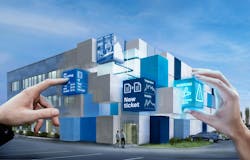You’ve no doubt heard digital twin technology being talked about as the next leap forward in the AEC industry. How it could make your job easier, your customers happier, and fundamentally change the way people interact with the buildings of tomorrow.
Finding a true digital replica today, however, is rare. Creating one is still a manual, expensive and highly bespoke process. So, what’s needed for AEC professionals right now, is a way to make digital twins accessible, and to begin making the process of creating one highly repeatable
With the recent release of Autodesk Tandem™, a new cloud-based platform is now available to allow you to do just that. With it, architects, engineers and construction firms can harness the BIM (Building Information Modeling) processes and data they’re already familiar with, and start their digital twin journey.
As the technology progresses, Autodesk will build on Tandem, using input from the AEC industry. The idea being that project teams will be among the first to deliver greater value to their Owner/Operator customers, through the delivery of operationally ready, data-rich digital twins at the project handover stage.
Taking you closer to digital twins
In the world of architects and construction engineers, a digital twin is a digital replica of a built asset or facility. Think of it as an active, adaptable, digital reflection of the physical building.
Now, let’s say your next project is an office building. Autodesk Tandem is a platform that allows you to harness your BIM data throughout the project’s development, and create a digital replica—essentially, a ‘first generation’ digital twin—of the building, that you can deliver to Owners and Facility Managers at handover.
This process allows the Owner to connect operational systems to the digital replica, so they can start managing their facilities even before they are occupied. So now, instead of handing over stacks of paper, mountains of disjointed data and fragmented information with the building keys, you’ll be giving your customer a digital asset of accessible, organized, and actionable data, helping them start to operate their facilities from Day One.
Why does the industry need this?
Ultimately, digital twins will provide the means to transform and enhance the entire lifecycle of a built asset. Verdantix proposed a five-step maturity model for digital twins with their value to business increasing at each tier. [Insert diagram of Verdantix model] When the digital twin technology reaches full maturity, it will be possible to predict system failures before they happen, perform "what-If" simulations, and provide rich insights into the operation, performance, and utilization of the built asset. The knowledge accumulated can then be used to plan future projects and improve design decisions for better ROI.
Autodesk Tandem is the simple way to start adopting the technology today. By integrating with software you already have (or already work with) you can extend your workflows and improve efficiency. You’ll enjoy unparalleled project clarity, because you’ll have the ability to track every change made to the digital replica by other responsible parties. You’ll be able to verify contributions from different disciplines and optimize data accuracy—from initial design through to construction.
How Autodesk Tandem will make digital twins accessible
As the leader in BIM, Autodesk is able to help AEC firms build digital twins from existing BIM workflows. This will allow you to be among the first to make digital twins accessible to your building Owner (or Operator) customers.
BIM is the logical path to high-value digital twins, as many firms are already familiar with different teams using it to share project data in a connected way. Because the standards for classifying building data and parameters used in the modeling process can differ between firms, a major priority for Autodesk Tandem was to create standardized data structures, so that as data is being captured or created, it will be normalized into the digital twin.
By establishing a workflow to specify the project’s operational and data requirements, data can be captured during design and construction while the project team verifies completeness at each milestone.
The result is that you’ll no longer be wasting time on bespoke processes and starting from scratch each time. Instead, you’ll be leveraging BIM to create an easily repeatable and scalable process to handover to your customers.
Three simple steps to a digital handover
If you have an upcoming project and you’d like to adopt the technology, here’s how to get started with Autodesk Tandem and use your BIM data throughout the project’s development to create a digital replica—essentially, a ‘first stage’ digital twin—of the built asset, that you can deliver to the Owner at handover.
1. Specify
Step One will be to work with the building Owner and Operator and have them specify the asset, space and system data they want to include in the project. Specifying data means you begin the project with the end in mind, ensure a streamlined process for data managers, and support productive collaboration between your project teams and the Owner or Operator of the built asset.
Data specification results in a way of working that’s repeatable and scalable. With Autodesk Tandem, you start by using the simplest of tools—our Facility Templates. These are the key to helping BIM Managers and your project teams achieve data consistency even across a portfolio of facilities.
Using these, you can either follow industry standards, use those standards as a starting point, or build your own. You can leverage our library of pre-defined parameter sets (or, again, create your own) to define what data needs to be managed within your digital twin. Finally, you can define your template to find which parameter sets apply to each asset type in your asset breakdown structure.
2. Capture
Once the data has been specified, BIM Managers and project team members can now contribute to a single digital hub by capturing all the necessary data for each and every stage of the project. This includes the design and engineering intent, combined with the as-built installation and commissioning data.
All through the project, Autodesk Tandem lets you visualize, add to, or update the captured data, ensuring clarity during collaboration between Project Managers and Owners. Data can come into Autodesk Tandem from Autodesk Revit, Autodesk BIM 360, and a growing set of model formats. Whether the model data is from Autodesk docs or other common data environments, it can all be added without losing metadata along the way, or inadvertently duplicating data entries.
3. Verify
With Autodesk Tandem, once the asset, space and system data are captured, it’s structured in a way that makes it simple to verify and validate, so that as things progress, you’ll know all data is accurate and complete.
Throughout the project you’ll be able to track every alteration made to the digital twin. Autodesk Tandem tracks every change—whether it comes from a Revit model update or an edit made in another application like Microsoft Excel. You’ll know who’s made it, too. Now everyone involved—BIM Managers, Capital Project Managers, Facility Managers—will be able to see a ‘digital thread’ of information relating to every space, system and asset in the facility. You’ll be able to validate that the right team contributes the right data at the right time.
…And repeat
Autodesk Tandem’s Facility Templates provide a consistent specification for the assets, spaces, and systems an Owner needs to manage. With this you can tag assets such as light fixtures or heating pumps with information, [and set parameters] such as manufacturer’s name, warranty end date, etcetera. This creates a highly repeatable process and brings data consistency across projects. That consistency gives Owners the power to roll-up and analyze data, not just for a single facility, but across their entire portfolio.
Tomorrow’s technology, today
Because you can leverage the investment you’ve already made in BIM, Autodesk Tandem allows you to adopt digital twin technology sooner, and capitalize on its growing business value faster. Tandem enables this by extending your existing workflows, integrating with software you already use—and giving the valuable data you create a new life in a digital twin.
Autodesk Tandem will also continue to be a platform that values open data standards and open APIs.
As time and technology progresses, through a continuous program of enhancements, Autodesk Tandem will work side-by-side with you on the journey to creating and deploying ‘autonomous’ digital twins that have the ability to learn, act and support project teams, Owners and Operators.
It takes just two minutes to create a free account and start using Autodesk Tandem. You can open Facility Templates, add team members and review your usage information—and as soon as you create your first new facility, you can begin uploading models.
So if you’re ready to take that first step, or you’d just like to find out more about Autodesk Tandem, go to https://intandem.autodesk.com
Disclaimers
Autodesk makes software and services available on a licensed or subscription basis. Rights to install, access, or otherwise use Autodesk software and services (including free software or services) are limited to license rights and services entitlements expressly granted by Autodesk in the applicable license or service agreement and are subject to acceptance of and compliance with all terms and conditions of that agreement. When you subscribe to a plan, it may renew automatically for a fixed fee on a monthly or annual basis, subject to availability. All benefits and purchase options may not be available for all software or services in all languages and/or geographies. Access to cloud services requires an Internet connection and is subject to any geographical restrictions set forth in the terms of use.
Autodesk, the Autodesk logo, Autodesk Tandem, are registered trademarks or trademarks of Autodesk, Inc., and/or its subsidiaries and/or affiliates in the USA and/or other countries. All other brand names, product names, or trademarks belong to their respective holders. Autodesk reserves the right to alter product and services offerings, and specifications and pricing at any time without notice, and is not responsible for typographical or graphical errors that may appear in this document. © 2021 Autodesk, Inc. All rights reserved.


